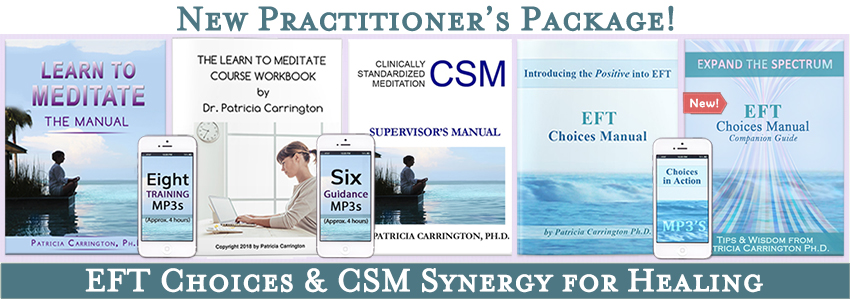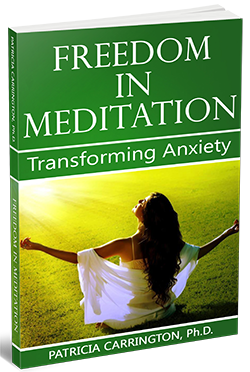Dr. Patricia Carrington’s award winning meditation technique CSM (Clinically Standardized Meditation) is a clinically sensitive meditation method used by numerous medical institutions, organizations, and individuals worldwide. For information click here.
Meditating to Increase Creativity
Patricia Carrington, Ph.D.
Author of “The Book of Meditation”
When asked whether meditation makes people ‘more creative’ I find it somewhat difficult to respond. The answer is both ‘Yes’ and ‘No’. Meditation helps some people develop certain characteristics we identify with creativity; but this does not make them artists, inventors or creative scientists if they do not have the interest in or ability for this sort of work. Meditation also helps others already in creative fields to develop their abilities further. On the other hand, many meditators who benefit from meditation in other respects have not become more creative, and some people already doing creative work do not want to meditate or do not continue meditating if they learn.
The relationship between meditation and creativity is difficult to pin down because ‘creativity’ does not seem to be a single characteristic. It is a combination of character traits or abilities which are only loosely linked and our methods for detecting even one of these qualities are not as yet exact. Despite such problems, however, when psychologists Marie Dellas and Eugene Gaier, of the State University of New York, reviewed the literature on creativity they were able to arrive at a composite picture of the ‘Creative person’. It sounds surprisingly like someone in a state of meditation.1
According to their study, the creative person is capable of an unusually flexible inwardly directed awareness which permits a much greater than usual use of ‘primary process thinking’. Primary process is the name given by Freud to the laws governing those unconscious processes which operate differently from familiar conscious thought. They are the ‘stuff that dreams are made of’ – a type of thinking using symbolic, often pictorial ways of expressing deeply buried needs and desires. The primary process tends to surface in drowsy states where the mind is unhampered by logical restrictions. It can produce bizarre images: the ‘absurdities’ we sometimes see in dreams, or the strange forms that hallucinations may take.
Creative breakthroughs which have occurred in dreams and other altered states of consciousness where primary process thought is prominent abound: Robert Louis Stevenson received his inspirations for most of his books from his dreams; the material for Chagall’s paintings was taken directly from his dreams; Howe was inspired by the idea of the needle with the hole at the bottom – an insight which enabled him to complete an operable sewing machine – from a dream; a reverie and a dream revealed to Kekule´ the structure of the benzene ring, and to Crick the DNA molecule. There are many other examples which illustrate that contact with primary process is an important factor in the creative process. This is significant because meditation encourages primary process thinking. Like the creative person, a meditator drifts from idea to idea and image to image during meditation, unhampered by the restrictions of commands or ‘shoulds’.
Ability to experience primary process thought is not in and of itself an index of creativity, however. This contacting of the unconscious must also be controlled; it needs to be integrated with and regulated by the conscious mind. Apparently it is neither the conscious nor the unconscious mode of functioning which is most useful for creativity, but rather the smooth interaction of these two different modes which leads to success in creative endeavors.
There is some research which has demonstrated this relationship between meditation and the ability to use primary process thought in a controlled fashion. Psychologist Terry Lesh used the Rorschach inkblot test as a means of measuring the amount of primary process thinking each person was able to use in a constructive manner. The subjects were psychological counselor trainees who were tested before and again after they had been practicing Zen meditation for a period of four weeks. At the end of this time, the ability to make constructive use of primary process thought had increased in the meditators, but had not changed in the non-meditating counselor trainees.2
In another study, psychiatrist Edward Maupin discovered that the more effectively his subjects handled primary process thought and visual images during their meditation, that is, the more comfortably they were able to experience this ‘freewheeling’ kind of thought without either suppressing it or allowing it to run away with them, the more satisfactory they afterward judged their meditation sessions to have been.3
Increased openness to experiencing emotion, and the ability to allow one-self to respond to problems on an intuitive level, are two additional personality traits which Dellas and Gaier found distinguished creative people from the average. Again, both these traits are frequently increased by meditation. Many meditation teachers encourage their students to adopt an intuitive approach rather than logical thinking. A Zen archer, flower-arranger, painter or poet is taught to allow his art simply to ‘happen’. He is to respond with a delicately attuned awareness to what is occurring, rather than to impose rational rules on the process. In the same way, a Westerner learning modern forms of mantra meditation is taught not to clutch at the mantra, but to allow it to ‘come to him’ in a natural, easy manner, without effort or planning.
The koans (riddles) used in Zen and the manner in which they are resolved also illustrate the way in which intuitive thinking is employed in meditation. Time after time the Zen student reaches an intellectual solution of the riddle, only to have it rejected by his Zen master, until finally an inner crisis is reached. Realizing that intellectual skills are worthless to solve the problem, the student then gives up the fight for a rational solution, lets go, and is said to ‘throw himself into the abyss’. It is then that ‘enlightenment’ occurs. Solving the koan, therefore, involves the ultimate rejection of the logical, linear intellectual approach in favor of an intuitive grasp of a problem. This letting go and ‘plunging into the abyss’ seems to correspond to the ‘creative leap’ which artists must make. Many creators report that much of their production takes place in an ‘egoless’ state similar to that during which a Zen student solves his koan.
Creative people also have access to a relatively unfocused kind of attention which Dellas and Gaier have called ‘perceptual openness’. This is the opposite of our usual ways of perceiving. What we ordinarily notice is almost always strongly limited by certain factors. Among these are our needs of the moment. If we walk down the street when we are hungry we will generally notice many restaurants and food stores but few, if any, movie theaters or shoe stores; children selling newspapers will not capture our attention, while those eating ice-cream cones will; the smell of a rose garden will go unnoticed while that of a barbecue will seem to fill the air.
In the same way, our past experience ordinarily limits what we perceive. When we walk down a particular street every day, in all likelihood we rarely notice the buildings on that street because we are familiar with them. We will, however, generally notice a new street, or a new building on a familiar street, immediately. Our perception of the unfamiliar tends to be keen. Because of this selective process, most things with which we come in contact are never fully registered in our consciousness. We see what we want to see, what we need to see, and by and large, what we expect to see.
A look at the history of certain creative breakthroughs suggests that this tightly programmed, limited mode of perception is not as typical of the successful artist or scientist as it is of the ordinary person. These gifted people’s thought tends to seek the unknown and move freely about, unrestricted by narrow goals. Creative people are said to be tolerant of changing situations and easily able to adopt fresh ways of seeing things. They are more ‘perceptually open’ than the rest of us. Because of this they will be aware of many things in their environment that may escape the so-called normal person, and they may also be able to remember and make use of this information more effectively.
Art is often an unusual presentation or arrangement of familiar objects, an ability to ‘make strange’ ordinary objects. This makes it possible to notice them as we would if they were entirely new to us. A Campbell’s soup can or a box of Morton’s salt is nothing when seen in the kitchen cabinet. If it is not presently needed, it goes unnoticed. Placed in a gallery, however, it becomes something startling. The artist who first puts an ordinary object into a painting is considered ‘creative’ because he has seen the object as no one has seen it before. The Zen masters would say he has been able to view it with ‘the eye of the beginner’, 4 a valued achievement in the Zen tradition.
Scientific discoveries as well as artistic ones require the ability to view an old problem from a new perspective; as do practical discoveries, those ‘inventions’ we all make when we meet a novel situation with an innovation in our everyday life. Instead of filing away a piece of information into a familiar ‘cubbyhole’ in the mind, the person in the process of inventing allows it to connect mentally with seemingly unrelated pieces of information. A wine press, for example, was used over the ages but inspired only thoughts of fragrant flowing liquid and revelry, until printing from wooden blocks was developed at the dawn of the fifteenth century. These diverse processes had never been connected in anyone’s mind, but Johann Gutenberg saw a wine harvest in a new light. Watching the power of the wine press, it occurred to him that the same steady pressure might be applied by a seal onto paper and the pressure could enable printing to take place. This inspired the invention of the printing press. While not all, perhaps not even most, unusual combinations of previously unrelated information turn out to be this useful; when they do they can be trail-blazing.
As psychologist Rollo May points out, “Obviously if we are to experience insights from our unconscious, we need to be able to give ourselves to solitude.”5 Meditation can be described as a state of inner solitude. During it, perceptual openness similar to that characterizing the thinking of creative people often seems to occur. The Hindu meditational tradition advocates the opening of the ‘third eye’, seeing more and more from a new vantage-point, and the Sufi sect of Persia views meditation as a means of developing an added perceptual organ which is said to enable one to overcome the limitations of the normal perceptual system. In addition, one of the general aims of traditional schools of meditation is a state called ‘non-attachment’, in which one is said to exist ‘without desires’. This state has some similarities to the attitude of creative persons who are not goal-bound but freer than most people to scan a vast field of impressions without becoming caught up in any one of them.
The opening-up of perceptions through meditation is, however, more than a momentary thing. It often influences a person’s general manner of responding to stimuli, both inner and outer, when he is not in meditation. As we have seen, yogis and Zen masters failed to habituate to clicks outside of meditation, indicating that they were unusually open to stimuli during their ordinary waking lives.
Even people who have been meditating for a relatively short period of time can experience increased perceptual openness. In a survey conducted as part of our research at Princeton University on the effects of meditation on personality, 73 percent of the subjects reported that they had improved in ‘awareness of external and internal environment’ after having meditated for three and a half months.
While meditation can affect certain aspects of creativity, it is unlikely that all the traits which cluster together in the creative person are affected by meditation. Some of them seem to be the result of heredity or personality drives so strong and fundamental that they are unlikely to be created or destroyed by any outside intervention. Three important aspects of creativity which do respond to meditation, however, are: productivity, originality and stamina, or ‘staying power’.
1. M. Dellas and E. L. Gaier, ‘Identification of Creativity: The Individual’, Psychological Bulletin, 73 (1970), pp. 55–73.
2. T. V. Lesh, ‘Zen Meditation and the Development of Empathy in Counselors’, Journal of Humanistic Psychology, 10 (1970), pp. 39–74.
3. E. W. Maupin, ‘Individual Differences in Response to a Zen Meditation Exercise’, Journal of Consulting Psychology, 29 (1965), pp. 139–45.
4. S. Suzuki, Zen Mind, Beginner’s Mind (New York: Walker/Weathethill, 1970).
5. R. May, The Courage to Create (New York: Norton, 1975), p. 67.






